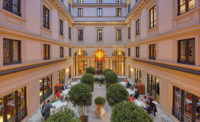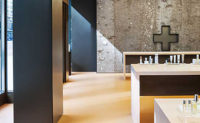Milan
Benedikt Taschen loves design. Though the German publisher is sometimes better known for "sexy" books—as some of his titles are cheekily referred to—he is the force behind scores of monographs on the world's most famous architects and fashion designers, and gorgeous limited editions on everyone from artist Ai Weiwei to James Bond. He also famously bought and restored the Chemosphere house in Los Angeles, by John Lautner, nearly 20 years ago, after it had languished on the market.
For the dozen stores Taschen built over the last two decades throughout Europe and the U.S.—at a time when many bookshops were closing—design was of the utmost importance. In 2000, Philippe Starck conceived the rollout of several Taschen stores from Berlin to Miami and designed subsequent outposts in Paris, New York, and Los Angeles. Taschen went in a different direction for the newest location, which opened in Milan during the city’s annual furniture fair and design week in April. “My father is a big fan and collector of Italian midcentury design, especially the work of Gio Ponti,” explains Marlene Taschen, director of business development, who, together with Benedikt, took a creative lead in building out the new store in the heart of Italy’s design capital.
Benedikt had wanted to open a store in Milan for some time. Finding the right spot, however, proved difficult, until they came upon a space once occupied by a cosmetics store in the Cinque Vie district—the oldest part of Milan. “It is a fantastic location,” says Marlene. “It is a real neighborhood, inhabited by locals and venerable establishments.”
Working with the company’s Dresden-based architect, Andreas Spiess, the Taschens spread the shop over the first two levels of the historic building. The 1,290-square-foot space celebrates the work of several designers, resulting in what Marlene describes as “a nice mix of influences, with a special homage to the genius of Italian design.”
That mix is immediately apparent upon entering, and blends in a strikingly harmonious way. Australian designer Marc Newson created a custom modular steel shelving system with bright yellow resin inlays that lines the walls and lends an industrial aesthetic, while a vibrant floral design by California artist Jonas Wood for the terrazzo flooring throughout the store provides an immersive tropical undercurrent. “The shelves are a flexible and practical way of displaying books that can be adapted to other stores and assembled in different ways,” says Spiess, internal architect of the Taschen stores since 2003. He was responsible for the overall layout, which includes storage and offices in the basement, and preservation of the landmarked facade.
The terrazzo floor, on the other hand, relied on traditional craftsmanship and age-old techniques. Wood sent sketches to an artisan in Rome who prepared the full-scale pieces in his workshop and then laid them out on-site using a styrofoam grid. The floor is finished off with polished brass borders to separate the foliage elements.
The centerpiece of the long, narrow ground-floor space is a large, round chandelier designed by Gio Ponti in the 1950s for the Hotel Parco dei Principi on Italy’s Amalfi Coast. Below it, a long table by Angelo Mangiarotti divides the space and offers an array of additional books for display. Ponti’s grandson, Salvatore Licitra, who, along with Alberto Stampanoni Bassi, has maintained Ponti’s archives, designed the multicolored Venetian terrazzo staircase, including a Ponti-style brass banister, and wood furniture on the ground floor.
An elegantly appointed alcove, intended as a quiet reading area, is tucked discreetly at the back of the ground floor. A sinuous wall drawing, by the London-based design consultancy Graphic Thought Facility, begins here and spirals along Licitra’s stair toward the upper level, where a collectors’ lounge, showcasing special editions, and a gallery for temporary exhibits are located. (The inaugural exhibit features the architectural photography of Julius Shulman.)
Wood continues the floral motif for the terrazzo on the second level, though its black background offers a stark juxtaposition with the light-colored floor below. Newson, with whom Taschen first collaborated on a limited-edition monograph in 2012, designed large glass-top cabinets for this level to showcase the publisher’s extra-large collector’s editions. Pieces from Benedikt Taschen’s personal collection, including Gio Ponti’s cowhide Dezza chairs and a colorful 1954 lamp by Flavio Poli, furnish and illuminate the space.
Taschen has a unique ability to look back as much as he can look forward, in both his business and personal choices, seeing opportunities where others do not. The new store is equally a celebration of the past greatness of Italian design, forever linked to the city of Milan, and a joyful embrace of the global influences that shape the world of design today.
PeopleClient: TASCHEN GMBH
Architect:
Interior designer:Jonas Wood (flooring) Photographer(s):Mark Seelen Size: 1,300 square feet Cost: withheld Completion Date: April 2015 |
Products
Interior finishes
Manufactured by Belloni Paints and stains: Yes
Wall coverings:
Solid surfacing:
Chairs:
Tables:
Other furniture:
Lighting 1 Gio Ponti chandelier for the Hotel Parco dei Principi, Rome (Benedikt Tashen’s personal collection)
First floor: |














Post a comment to this article
Report Abusive Comment